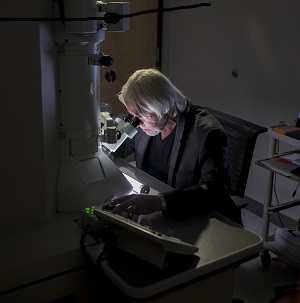Breadcrumb

"I didn't think you people could make me cry," said Dr. Robert Marc, after hearing John A. Moran Eye Center CEO Randall J Olson, MD, tell a packed house that "the thought of Robert not being here is hard for me to get a handle on."
Marc, Distinguished Professor of Ophthalmology and the Calvin and JeNeal Hatch Presidential Chair in Ophthalmology at the University of Utah, retired this month as Distinguished Professor Emeritus after 24 years at Moran. Marc (pictured left) will now devote his time to his heirloom apple orchard and crafting artisanal cider in the red-rock town of Torrey in Central Utah. Though he will still maintain a presence in the science as exciting projects are underway.
Long-time colleague Research Associate Professor Bryan W. Jones, PhD, will take over the lab.
"I knew when Robert came to Moran that we had somebody extraordinary, and he has lived up to that expectation in every possible way," said Olson at a farewell luncheon.
Marc joined Moran in 1993 from the University of Texas Houston where he held an endowed chair and was widely known for mapping the color receptors of the retina. While at Moran, Marc established a notable career mapping the remarkably complex circuitry of the retina.
The Marc lab demonstrated that blinding diseases such as age-related macular degeneration (AMD) and retinitis pigmentosa began by a rewiring of the neural circuits in the eye, but no one had a complete idea about what that circuitry looked like or how it worked. To begin to understand those diseases, he and his team created what was then a "dream" of a complete wiring diagram of the retina, now called a connectome.
In 2011, the Marc lab unveiled this retinal connectome, a map of unprecedented completeness and resolution. It was the first complete interactive digital image of the network of nerves and neurons that make up the retina a map so dense it could zoom down to the level of an individual synapse and gap junction. Today, the "Robert Marc Laboratory for Connectomics" now under the leadership of Jones, is the lead team in discovering the nature and scope of retinal circuitry and the changes in that circuitry found in diseases called remodeling
 Wolfgang Baehr, PhD, will take the helm from Marc as Moran's new director of research. Baehr described Marc's contributions to the department as invaluable, noting he brought National Institutes of Health training grants and new, powerful microscopes to Moran.
Wolfgang Baehr, PhD, will take the helm from Marc as Moran's new director of research. Baehr described Marc's contributions to the department as invaluable, noting he brought National Institutes of Health training grants and new, powerful microscopes to Moran.
Marc reflected back on his time at Moran as an unique experience.
"There is no place like Moran on the planet," said Marc. "It changed me in so many ways. But in the life of letters and science, nothing happens without huge teams of people. Moran is a fabulous place because of the people who work here and because of the vision of Randy Olson."
Jones' career has taken a parallel arc to that of Marc's by helping to make connectomics a reality and looking at what happens to the neural circuitry in retinal disease. He plans to build on Marc's legacy to focus on disease.
"We'll use the same principles developed here in the Marc lab over the past decade and apply them to disease," said Jones (pictured at right). "We're working to understand how retinal wiring changes in diseases like retinitis pigmentosa and AMD. All of this tells us potentially more about the process of the biology of remodeling and retinal degeneration so that we can better target therapies to intervene."